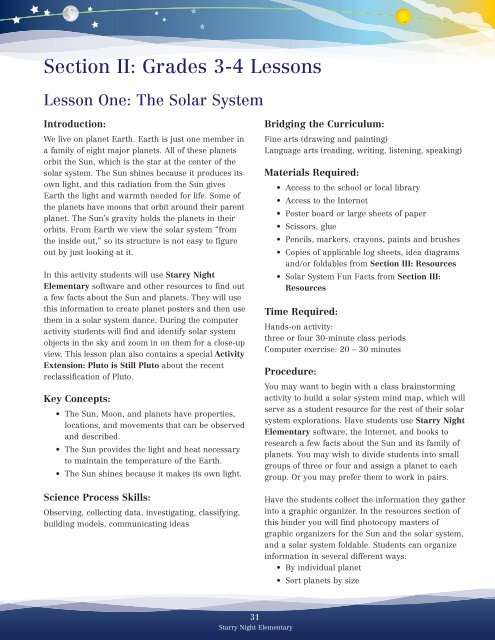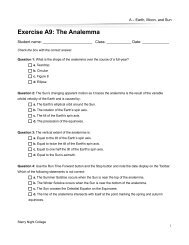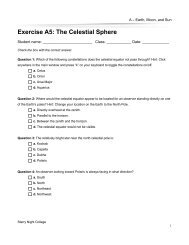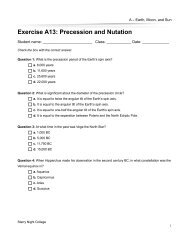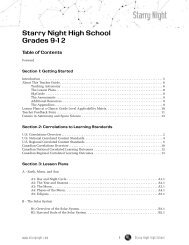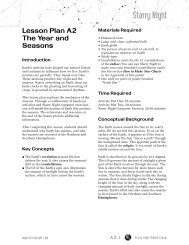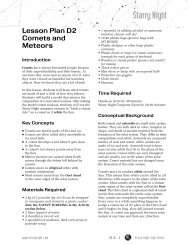Grades 3-4 Lessons - Starry Night Education
Grades 3-4 Lessons - Starry Night Education
Grades 3-4 Lessons - Starry Night Education
You also want an ePaper? Increase the reach of your titles
YUMPU automatically turns print PDFs into web optimized ePapers that Google loves.
Section II: <strong>Grades</strong> 3-4 <strong>Lessons</strong><br />
Lesson One: The Solar System<br />
Introduction:<br />
We live on planet Earth. Earth is just one member in<br />
a family of eight major planets. All of these planets<br />
orbit the Sun, which is the star at the center of the<br />
solar system. The Sun shines because it produces its<br />
own light, and this radiation from the Sun gives<br />
Earth the light and warmth needed for life. Some of<br />
the planets have moons that orbit around their parent<br />
planet. The Sun’s gravity holds the planets in their<br />
orbits. From Earth we view the solar system “from<br />
the inside out,” so its structure is not easy to figure<br />
out by just looking at it.<br />
In this activity students will use <strong>Starry</strong> <strong>Night</strong><br />
Elementary software and other resources to find out<br />
a few facts about the Sun and planets. They will use<br />
this information to create planet posters and then use<br />
them in a solar system dance. During the computer<br />
activity students will find and identify solar system<br />
objects in the sky and zoom in on them for a close-up<br />
view. This lesson plan also contains a special Activity<br />
Extension: Pluto is Still Pluto about the recent<br />
reclassification of Pluto.<br />
Key Concepts:<br />
• The Sun, Moon, and planets have properties,<br />
locations, and movements that can be observed<br />
and described.<br />
• The Sun provides the light and heat necessary<br />
to maintain the temperature of the Earth.<br />
• The Sun shines because it makes its own light.<br />
Science Process Skills:<br />
Observing, collecting data, investigating, classifying,<br />
building models, communicating ideas<br />
Bridging the Curriculum:<br />
Fine arts (drawing and painting)<br />
Language arts (reading, writing, listening, speaking)<br />
Materials Required:<br />
• Access to the school or local library<br />
• Access to the Internet<br />
• Poster board or large sheets of paper<br />
• Scissors, glue<br />
• Pencils, markers, crayons, paints and brushes<br />
• Copies of applicable log sheets, idea diagrams<br />
and/or foldables from Section III: Resources<br />
• Solar System Fun Facts from Section III:<br />
Resources<br />
Time Required:<br />
Hands-on activity:<br />
three or four 30-minute class periods<br />
Computer exercise: 20 – 30 minutes<br />
Procedure:<br />
You may want to begin with a class brainstorming<br />
activity to build a solar system mind map, which will<br />
serve as a student resource for the rest of their solar<br />
system explorations. Have students use <strong>Starry</strong> <strong>Night</strong><br />
Elementary software, the Internet, and books to<br />
research a few facts about the Sun and its family of<br />
planets. You may wish to divide students into small<br />
groups of three or four and assign a planet to each<br />
group. Or you may prefer them to work in pairs.<br />
Have the students collect the information they gather<br />
into a graphic organizer. In the resources section of<br />
this binder you will find photocopy masters of<br />
graphic organizers for the Sun and the solar system,<br />
and a solar system foldable. Students can organize<br />
information in several different ways:<br />
• By individual planet<br />
• Sort planets by size<br />
31<br />
<strong>Starry</strong> <strong>Night</strong> Elementary
• Sort by distance from the Sun (near or far)<br />
• Sort by type of planet (solid or gas)<br />
• Sort by whether or not the planet has moons<br />
or rings<br />
Now divide students into ten small groups: one for<br />
each of the eight planets, one for the Moon, and one<br />
for the Sun. Have each small group research a few<br />
facts about their solar system object and then create<br />
a colorful poster for the classroom wall that displays<br />
the results of the group research. See figure 1.1 for<br />
an example.<br />
For an additional activity on the properties of the<br />
solar system, see activity part B in K-2 Lesson Two:<br />
How Big is it?<br />
Our Moon<br />
It has phases.<br />
It looks like it changes shape.<br />
There are lots of craters on the Moon.<br />
The Moon’s gravity makes tides on<br />
Earth.<br />
The craters make a face on the Moon.<br />
People have walked on the Moon<br />
The Sun is a star.<br />
It’s really hot!<br />
Our star is a big ball of burning gas.<br />
It makes it’s own heat and light.<br />
It’s ball-shaped.<br />
It warms Earth.<br />
Planets orbit around it.<br />
It will live for billions of years.<br />
It’s old.<br />
Figure 1.1. Shown here are examples of two possible solar system posters that students might create. Note<br />
that some of the answers students provide may not be strictly correct. For example, it is the Mare (large impact<br />
basins), not the craters, that creates the impression of the “Man in the Moon”.<br />
32<br />
<strong>Starry</strong> <strong>Night</strong> Elementary
Students can now use their completed posters to help<br />
them perform a solar system dance. You may want<br />
each group to elect one student to represent their<br />
planet. Or you may want to do the dance two or<br />
three times so everyone has a chance to perform.<br />
Have the dancers arrange themselves as the planets<br />
around the Sun, and move in orbits around the Sun.<br />
Earth should spin on its axis as it orbits the Sun,<br />
and the Moon should orbit around Earth as Earth<br />
orbits around the Sun. See figure 1.2.<br />
If you wish to include the dwarf planet Pluto in<br />
your dance, the student representing this newly<br />
reclassified object will have to find a way to represent<br />
its unusual orbit. Standing up on a table in the<br />
farthest corner of the classroom would be a good<br />
approximation for Pluto.<br />
Figure 1.2. The solar system dance.<br />
Earth<br />
Moon<br />
Sun<br />
Mars<br />
Questions for Discussion:<br />
As students research the solar system, make posters,<br />
and prepare to perform the solar system dance, ask<br />
them to consider these questions:<br />
1. Which object is at the center of the solar system?<br />
2. What object do the planets orbit around?<br />
3. What objects do moons orbit around?<br />
4. From what object do the planets receive light<br />
and warmth?<br />
5. Can you think of anything that behaves like the<br />
solar system? (A merry-go-round.)<br />
When your students have completed their solar system<br />
adventures, hang the posters on the classroom wall,<br />
in the correct order from the Sun outwards.<br />
33<br />
<strong>Starry</strong> <strong>Night</strong> Elementary
The Sun<br />
Mercury Venus Earth/Moon Mars<br />
Jupiter<br />
Saturn Uranus Neptune<br />
Figure 1.3. This illustration shows the correct relative sizes of the Sun and eight major planets.<br />
It does not show correct distances.<br />
34<br />
<strong>Starry</strong> <strong>Night</strong> Elementary
<strong>Starry</strong> <strong>Night</strong><br />
Computer Exercise<br />
In this exercise, your students will become acquainted<br />
with some features of the solar system. The activity<br />
begins with a view of Earth and Moon from a satellite<br />
orbiting 1000 km above the surface of the Earth.<br />
Open the SkyGuide pane, and navigate to<br />
<strong>Lessons</strong> > <strong>Grades</strong> 3-4 > Lesson One: The Solar<br />
System and follow the instructions given.<br />
Conclusion:<br />
This lesson plan is an introduction to the solar system.<br />
Once completed, students should know that the Sun<br />
lies at the center of the solar system, the planets move<br />
in orbit around the Sun, and some planets (like Earth)<br />
have moons in obit around them. Students should<br />
know that the Sun shines by making its own light,<br />
and that it provides light and warmth to Earth and<br />
the other planets.<br />
Extension Activity: Pluto is Still Pluto<br />
Any discussion of the solar system will naturally<br />
involve Pluto and its recent reclassification from planet<br />
to dwarf planet. Pluto seems to have a place in<br />
everyone’s heart. Maybe this is because it shares its<br />
name with a certain cartoon dog, and because it seems<br />
also to be the solar system’s planetary underdog.<br />
In August 2006, the International Astronomical<br />
Union changed Pluto’s status from planet to dwarf<br />
planet. But this is not the first time the solar system<br />
has been revised. It has happened several times in<br />
the history of astronomical science. Such events are<br />
part of the normal process of science.<br />
The scientists’ job is to question and explore. They<br />
are constantly re-evaluating ideas in the light of new<br />
information. New technologies, space probes, and<br />
advances in computing and remote sensing have<br />
allowed us to study the solar system in greater detail.<br />
New discoveries made it plain that some of our<br />
previously held ideas were incorrect. A review was<br />
in order.<br />
Scientists looked at all the known characteristics of<br />
planets, asteroids, comets and other objects in the<br />
solar system. They considered behavior in addition<br />
to physical properties. In the end, they knew they<br />
had to reclassify things to make sense of the new<br />
and better information about the solar system.<br />
Pluto has been reclassified. It has not been “demoted.”<br />
It is now one of the largest members of a new class<br />
of solar system objects: the dwarf planets. Pluto itself<br />
has not changed. It is still the same distant, small,<br />
cold, rocky and icy lump of which we are so fond.<br />
The reclassification of Pluto highlights a few key<br />
concepts regarding the nature of science itself.<br />
They are:<br />
• Science is not a static body of facts, but an<br />
ongoing process subject to constant revision.<br />
• The history of astronomy is a history of<br />
changing worldviews as a result of new<br />
and better data.<br />
• Refining the classification of solar system<br />
objects does not change the nature of Pluto.<br />
35<br />
<strong>Starry</strong> <strong>Night</strong> Elementary
Be an Astronomer: Play “Sort the Planets”<br />
By reclassifying Pluto, scientists were engaging in a type of solar system sorting game. They needed to find a<br />
better way to sort the planets so they could make more sense of the solar system. You can mimic the situation<br />
with your students by playing a sorting game using marbles.<br />
Suppose you have a number of marbles of different<br />
types: large, small, single-colored and multi-colored.<br />
How can they be sorted?<br />
They can be sorted as large and small. Both groups<br />
contain marbles that are similar and marbles that<br />
are different.<br />
Or they can be sorted as single-color and multicolored<br />
marbles. But each group still contains<br />
more than one type of marble.<br />
Or you can create new categories and sort them with<br />
much greater clarity, as large single-color, large<br />
multi-color, small multi-color, and small single-color.<br />
Now each group contains only one type of object and<br />
the distinction between the four categories is clear.<br />
This is analogous to what astronomers have done with a new solar system classification. The new sorting<br />
scheme helps us understand the solar system in greater depth.<br />
36<br />
<strong>Starry</strong> <strong>Night</strong> Elementary
Idea Diagram<br />
Name:<br />
Class:<br />
Lesson One: the Solar System<br />
37<br />
<strong>Starry</strong> <strong>Night</strong> Elementary
Computer Exercise Log Sheet<br />
Name:<br />
Class:<br />
Lesson One: the Solar System<br />
Instructions for the student<br />
Open the SkyGuide pane, and navigate to <strong>Lessons</strong> > <strong>Grades</strong> 3-4 > Lesson One:<br />
The Solar System and follow the instructions given.<br />
Question 1: The Earth and Moon<br />
Can you describe the motion of the Earth and the Moon?<br />
Question 2: The Earth in Orbit<br />
Can you describe the two different motions the Earth has?<br />
Question 3: The Inner Solar System<br />
What other planets can you see circling the Sun?<br />
Question 4: The Outer Solar System<br />
What are the rest of the planets in the solar system called?<br />
38<br />
<strong>Starry</strong> <strong>Night</strong> Elementary
Answer Key for <strong>Starry</strong> <strong>Night</strong> Computer Exercise<br />
Lesson One: The Solar System<br />
Question 1: The Earth and Moon<br />
Can you describe the motion of the Earth and the Moon?<br />
Possible Answer: The Earth is rotating on its axis. The Moon goes (or orbits) around the Earth.<br />
Teaching Tips<br />
• Students should be able to clearly see the rotation of the Earth as well as the motion of the Moon along its<br />
orbit.<br />
• If you allow the simulation to run long enough, you will see a beautiful “moonset.”<br />
• Remember you can always stop or reset the simulation as required.<br />
Question 2: The Earth in Orbit<br />
Can you describe the two different motions the Earth has?<br />
Possible Answer: The Earth rotates and orbits the Sun.<br />
Teaching Tips<br />
• The Earth’s orbit appears oval shaped because it is viewed from an angle. Seen face-on, it would be close to<br />
a perfect circle.<br />
• Students may need to be reminded that the Earth has been greatly magnified to show its rotation.<br />
• All stars have been removed from the screen. The other two (moving) points are planets. Stop the motion<br />
and use the cursor to identify them.<br />
Question 3: The Inner Solar System<br />
What other planets can you see circling the Sun?<br />
Possible Answer: Mercury, Venus and Mars.<br />
Teaching Tips<br />
• The animation shows the relative distances and speed of the inner planets.<br />
• You may wish to stop the animation on December 31, 2006 to show the appearance of the very bright comet<br />
McNaught. Advancing time stepwise until January 24, 2007, shows the comet’s motion around the Sun as<br />
well as the changes in its tail.<br />
• Choosing the larger-image simulation allows students to see some surface detail on each of the planets.<br />
Simply stop the animation when the chosen planet is well illuminated.<br />
Continued on next page<br />
39<br />
<strong>Starry</strong> <strong>Night</strong> Elementary
Answer Key for <strong>Starry</strong> <strong>Night</strong> Computer Exercise<br />
Lesson One: The Solar System<br />
Question 4: The Outer Solar System<br />
What are the rest of the planets in the solar system called?<br />
Possible Answer: Jupiter, Saturn, Uranus and Neptune.<br />
Teaching Tips<br />
• Students may need to be reminded that Pluto is no longer a major planet and does not show up here.<br />
• If you prefer to see all planets at once, see the bottom of the SkyGuide screen.<br />
• Choosing the larger-image simulation allows students to see some surface detail on each of the planets.<br />
Simply stop the animation when the chosen planet is well illuminated.<br />
Extension<br />
Planets rise and set just like the stars. But they also move in a different way. <strong>Starry</strong> <strong>Night</strong> Elementary<br />
software can show you how the planets move against the background of the stars.<br />
Teaching Tips<br />
• The animation clearly shows that some planets move faster than others.<br />
• The direction of each planet’s motion is the combination of that planet’s and Earth’s orbital motion. Detailed<br />
discussion of this effect is probably not appropriate for this level.<br />
40<br />
<strong>Starry</strong> <strong>Night</strong> Elementary


